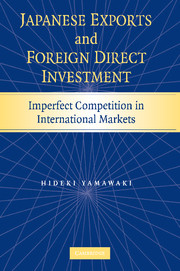Book contents
- Frontmatter
- Contents
- Tables
- Figures
- Preface
- 1 Introduction
- 2 Export Pricing Under Imperfect Competition
- 3 Export Price, Learning, and Domestic Demand Disturbances
- 4 Foreign Market Structure, Export Price, and Profitability
- 5 Competitive Advantage and Export Performance
- 6 Entry in the European and U.S. Manufacturing Industries
- 7 Strategic Interactions in Cross-Market Entry
- 8 Responses of Foreign Firms to Japanese Competition
- 9 Exit in the U.S. Manufacturing Industries
- 10 Interpreting the Empirical Findings
- 11 Implications
- Appendixes
- References
- Index
8 - Responses of Foreign Firms to Japanese Competition
Published online by Cambridge University Press: 08 January 2010
- Frontmatter
- Contents
- Tables
- Figures
- Preface
- 1 Introduction
- 2 Export Pricing Under Imperfect Competition
- 3 Export Price, Learning, and Domestic Demand Disturbances
- 4 Foreign Market Structure, Export Price, and Profitability
- 5 Competitive Advantage and Export Performance
- 6 Entry in the European and U.S. Manufacturing Industries
- 7 Strategic Interactions in Cross-Market Entry
- 8 Responses of Foreign Firms to Japanese Competition
- 9 Exit in the U.S. Manufacturing Industries
- 10 Interpreting the Empirical Findings
- 11 Implications
- Appendixes
- References
- Index
Summary
Introduction
As Japanese firms in engineering-intensive industries expanded their international operations in the late 1980s, their product focus also shifted from low-end products to middle-range products, and further to high-end products. The most notable example of such upward shifts in product segments was observed in the automobile industry in the late 1980s. Although Japan's automobile manufacturers succeeded in penetrating the international markets based on their competitive advantages in production efficiency and product quality in small-sized and middle-range passenger vehicles, they were not yet a major competitive force in the high-end luxury car segment in the late 1970s and the early 1980s. Contrary to the low-end and mid-segment, European manufacturers were historically strong competitors in the high-end luxury segments worldwide. In the U.S. passenger car market, German, British, and U.S. firms had been the major players in the luxury segment after World War II. A notable change in market structure, however, occurred in the late 1980s when Japanese firms entered the luxury segment of the U.S. passenger car market. Chapter 4 investigated their entry process in the U.S. market and described how Japanese firms took advantage of their competitiveness and implemented a policy to set export price at a level that undercut incumbents' price. When measured by market share, the newly established brands of Japanese automakers, such as Toyota's Lexus, were no doubt very successful in penetrating the U.S. market that had been entrenched by the existing European and U.S. luxury brands.
- Type
- Chapter
- Information
- Japanese Exports and Foreign Direct InvestmentImperfect Competition in International Markets, pp. 145 - 161Publisher: Cambridge University PressPrint publication year: 2007



